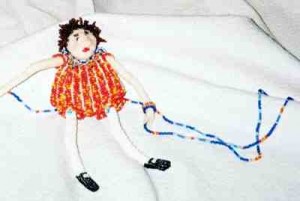Article by Marcia Darnell
Water – May 2008 – Colorado Central Magazine
“Water, water everywhere, nor any drop to drink”
— Samuel Taylor Coleridge
The Rime of the Ancient Mariner
IT’S INTERESTING when your little town makes the national spotlight. Of course, it’s not so cool when that attention is for something bad. And it’s extremely un-fun when that something bad affects your daily life.
Sometime around March 9, the city-supplied water became tainted with salmonella, an ugly bacterium that, when ingested, causes vomiting, diarrhea, bloody diarrhea, and even death. Subsequent tests identified other bugs in the water, including giardia.
Once the culprit was identified, we residents were on yellow alert, told not to drink the water or use it for food prep, washing dishes, or anything else that might result in snarfing down the bug. Alamosa was descended upon by public health officials, water works experts, volunteers, and reporters.
And there was plenty of room for them — half the city seemed to have bugged out. A drive downtown the morning after the alert was like a jaunt after midnight: very light traffic and plenty of parking.
The yellow alert escalated to red when the chlorine flush began and we couldn’t use the water for anything except flushing the toilet. It was like being on a camping trip at home, using bottled water for brushing teeth, taking sponge baths in a basin, and eating with disposable plates and utensils.
There was no watering of vegetable gardens, and we couldn’t use ammonia-based cleansers, since flushing them down a system loaded with chlorine could’ve been highly unpleasant.
As tough rural Coloradans should, we coped with it. Schools closed, including Adams State College. Grocery stores used other water for washing produce. Restaurants served food on paper plates and every drink was “to go.” Salons did only dry styling, and laundry employees got a sudden vacation.
Local writer Michelle LeBlanc rechristened our town “Salamosa.”
A massive volunteer response ensured free water to those willing to wait in line; grocers stocked piles of bottles for those willing to pay.
The hospital was ready. Surgery went on, autoclaves were adjusted, and the staff used blanket warmers to heat water for sponge baths.
“Hospitals have a disaster planning process, with training exercises,” said Gwen Heller, the administrator on call when the crisis hit. “We immediately began implementing that.
“I wouldn’t call it a disaster.”
The ER treated those who came in with the bug, and the hospital’s lab did the water testing. “We had nine or 10 staff members come down with it,” said Heller.
OTHER BUSINESSES didn’t fare as well, especially those catering to visitors. “It took us out of business,” said Clancy Spicer, owner of the Inn of the Rio Grande. He said cancellations and no-shows dropped occupancy down to 10 percent, and the hotel’s restaurant suffered proportionately.
“We also had cancellations of meetings and local business,” Spicer said, adding philosophically, “It’ll take some time after this is over to rebound even statewide.”
One lawsuit has been filed against the city by the parents of a child sickened by the contamination.
On the sunny side, generosity abounded in town, from folks hauling water for neighbors, to those with camping experience demonstrating the use of a solar shower for neophytes, to the owners of the Comfort Inn, who offered free showers to Alamosans.
The El Pomar Foundation gave money to four non-profits for helping others through the crisis, and the federal Small Business Administrator is offering loans to businesses crunched by the incident.
The city’s bill for this little growth experience should top $600,000. The governor is diverting about $300,000 to help us, but a bill that would have kicked in $262,000 to help pay the tab died. Our state senator, Gail Schwartz, voted against it.
And of course there were those slimeballs who tried to profit from the crisis. Scammers tried to solicit money to buy water for the needy, and someone claiming to be from the EPA went door to door asking people for their IDs.
BUT ALAMOSA PREVAILED, and as of press time, we were on the verge of normal again. We residents know, again, that we’re tough. However, the cause of the contamination may never be known.
The source is still not identified,” said City Clerk Judy Egbert. “The investigation will take some time.”
The city will now chlorinate its water to prevent future outbreaks, and businesses are encouraged to install backflow prevention devices.
“The chlorine from here forward will kill anything that might come in the water,” said Egbert. The crisis also revealed the continued use of old iron pipes in the system, which may lead to an upgrade.
Deputy Mayor Kathy Rogers was the voice of calm in the initial stages of the emergency.
“My focus was that we remained strong, our whole council, strong united and focused on the safety of our citizens,” she said. “We were so fortunate to have so many people step up. It wasn’t any one person, but so many people who got us through it.”
Rogers said many volunteers commented on how well the community coped, and how people weren’t freaking out. “I think that speaks well of us,” she said.
“We have really seen a lot of good in people over this,” Egbert agreed. “It’s been a frustrating time, but we’ve seen patience and good attitudes and willingness to volunteer.”
During this to-do, folks in Del Norte couldn’t drink their town’s water due to a fire at the pump station, which led to ash in the water from putting out the fire.
“We were without water for about four days,” said Del Norte resident Pauline Washburn. “The town coped really well. We had water trucks with free distribution, and people bought water for their neighbors.”
Alamosa did well, too. In the end, 383 cases of salmonella were reported, with no telling how many people who got it but just stayed home and rode it out. No one died, the crisis was met and conquered, and maybe — for a while — people here will have a little more appreciation for what happens when we turn on a tap.
Drink up.
Marcia Darnell lives in Alamosa with no garden, two cats, and a frequent hand-washing habit.


